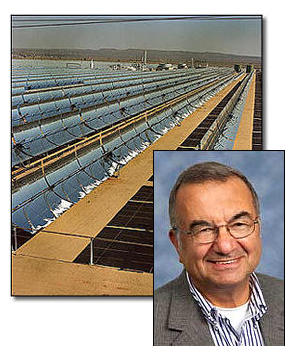
Image: NREL, U of Chicago Chronicle
 |
Solargenix's
solar thermal technology is based on Roland Winston's research. (LUZ
Kramer junction solar thermal in the background.) Image: NREL, U of Chicago Chronicle |
"There's an opportunity in the United States to produce a tremendous
amount of thermal and electric energy from the sun."
- Solargenix director of legal and administration, Jeff Myles
| Chicago, Illinois
- April 16, 2004 [SolarAccess.com] Standing before television news
cameras on the factory floor of Solargenix Energy in Chicago during a
Tuesday, March 30 news conference, entertainer Art Linkletter proclaimed
the start of a new era in energy production. The reason: the highly
efficient solar collectors invented by Roland Winston, a Senior
Scientist in the Enrico Fermi Institute. "We have, through Dr. Winston, a patent on the sun," Linkletter said. Linkletter is an investor in Solargenix Energy, which is based on Winston's non-imaging optics technology. Solargenix has exclusive worldwide licenses and rights from the University to develop and market the technology for all solar applications. Chicago Mayor Richard Daley had called the news conference to announce that Solargenix had just opened a factory at 3622 S. Morgan St., as a result of economic incentives offered by the city. "This is an excellent example of what we can accomplish through the synergy of the city, the private sector and our universities," Daley said. Solargenix will receive a $1.7 million loan from the city, to be repaid over five years. The city and its sister agencies also agreed to buy $5 million worth of solar thermal collectors to install in their buildings over the next three years. The company designs, markets, manufactures, installs and maintains a variety of patented solar-energy systems capable of producing hot water, steam or electricity for residential, industrial, institutional, commercial and utility customers. While teaching and conducting research at the University as a physics professor, Winston invented and developed the technology that Solargenix commercializes. Winston's invention uses an innovative optical surface called a compound parabolic concentrator to concentrate light more intensively than traditional optics. In some applications, this technology has proven the capability to concentrate sunlight up to 84,000 times the natural level of sunlight at Earth's surface. This exceeds the intensity of the surface of the sun by 15 percent. Non-imaging optics serve as light funnels that collect and intensify radiation far better than do lenses and mirrors, Winston said. Lenses and mirrors produce almost perfect images at the focal point, but they blur and broaden the images away from the focus. The technology has another advantage. It collects light from much of the sky, so it requires no moving parts to track the sun. Similarly, the technology also is used to enhance tracking solar collection systems. Conventional solar arrays must move over a range of 60 degrees from winter to summer in order to collect direct radiation from the sun. Winston traces his interest in collecting light with maximum efficiency to a course he took while a graduate student at the University about 40 years ago with the late Subrahmanyan Chandrasekhar. Chandrasekhar, who received the Nobel Prize in physics in 1983, taught Winston that the sine law was the most important principle in optics. The sine law dictates how efficiently light can be concentrated, yet solar-energy researchers failed to apply the principle to their work. Winston began working intensively on the problem himself in 1973. By the 1980s, manufacturers in the United States, Israel, Japan and Europe had launched the technology in demonstration projects. The first application of the Solargenix Power Roof, a roof-integrated solar cooling and heating system, began operation in Raleigh, N.C., in July 2002. The system provides 50 tons of solar-driven space cooling using Winston's non-imaging optics. "I'm driven by the mathematics of these non-imaging optics, which is very pretty," Winston said. "The fact that it is also useful is great. This makes high-temperature solar energy practical." A former chairman of the Physics Department, Winston left his professorship at the University in 2003 to become a founding faculty member of the University of California, Merced. He remains affiliated with the University's Enrico Fermi Institute. Solargenix director of legal and administration, Jeff Myles, noted that Winston's office at the University sat directly across the street from the site where Fermi and his colleagues produced the first controlled nuclear chain reaction in 1942. Just as Fermi tapped nuclear energy, which powers the sun, so has Winston's invention harnessed solar energy to drive technology. "There's an opportunity in the United States to produce a tremendous amount of thermal and electric energy from the sun," Myles said. "At Solargenix, we know that Winston's inventions are going to enhance that capability and could lead to a revolution in new energy production." Aricle by Steve Koppes, Reprinted Courtesy of the University of Chicago Chronicle |
|
|
| For
Further Information: • Solargenix • University of Chicago Chronicle Please Note: SolarAccess.com and Arizonaenergy.org do not endorse the sites behind these links. We offer them for your additional research. Following these links will open a new browser window. |